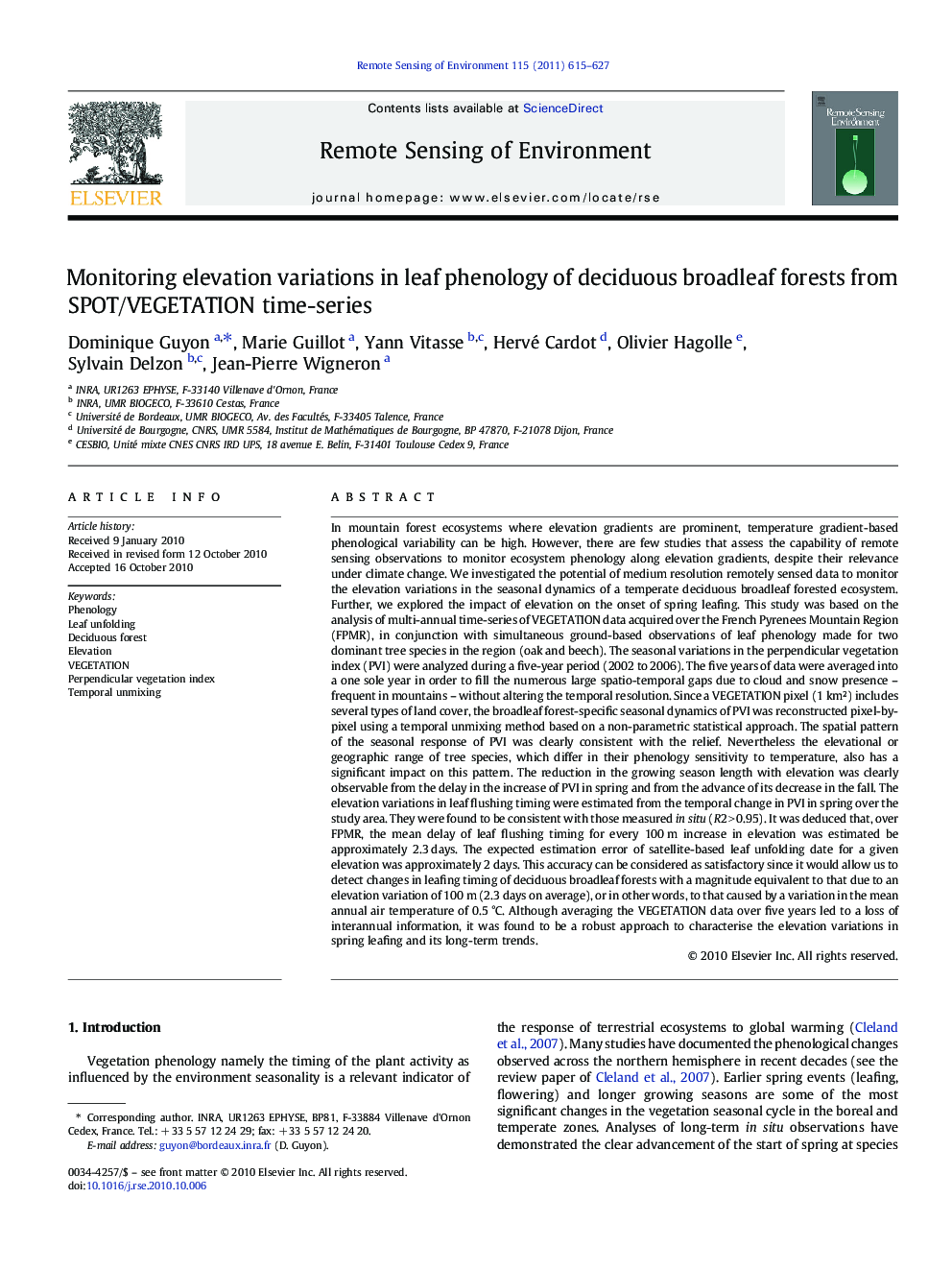| کد مقاله | کد نشریه | سال انتشار | مقاله انگلیسی | نسخه تمام متن |
|---|---|---|---|---|
| 4459661 | 1621295 | 2011 | 13 صفحه PDF | دانلود رایگان |

In mountain forest ecosystems where elevation gradients are prominent, temperature gradient-based phenological variability can be high. However, there are few studies that assess the capability of remote sensing observations to monitor ecosystem phenology along elevation gradients, despite their relevance under climate change. We investigated the potential of medium resolution remotely sensed data to monitor the elevation variations in the seasonal dynamics of a temperate deciduous broadleaf forested ecosystem. Further, we explored the impact of elevation on the onset of spring leafing. This study was based on the analysis of multi-annual time-series of VEGETATION data acquired over the French Pyrenees Mountain Region (FPMR), in conjunction with simultaneous ground-based observations of leaf phenology made for two dominant tree species in the region (oak and beech). The seasonal variations in the perpendicular vegetation index (PVI) were analyzed during a five-year period (2002 to 2006). The five years of data were averaged into a one sole year in order to fill the numerous large spatio-temporal gaps due to cloud and snow presence – frequent in mountains – without altering the temporal resolution. Since a VEGETATION pixel (1 km²) includes several types of land cover, the broadleaf forest-specific seasonal dynamics of PVI was reconstructed pixel-by-pixel using a temporal unmixing method based on a non-parametric statistical approach. The spatial pattern of the seasonal response of PVI was clearly consistent with the relief. Nevertheless the elevational or geographic range of tree species, which differ in their phenology sensitivity to temperature, also has a significant impact on this pattern. The reduction in the growing season length with elevation was clearly observable from the delay in the increase of PVI in spring and from the advance of its decrease in the fall. The elevation variations in leaf flushing timing were estimated from the temporal change in PVI in spring over the study area. They were found to be consistent with those measured in situ (R2 > 0.95). It was deduced that, over FPMR, the mean delay of leaf flushing timing for every 100 m increase in elevation was estimated be approximately 2.3 days. The expected estimation error of satellite-based leaf unfolding date for a given elevation was approximately 2 days. This accuracy can be considered as satisfactory since it would allow us to detect changes in leafing timing of deciduous broadleaf forests with a magnitude equivalent to that due to an elevation variation of 100 m (2.3 days on average), or in other words, to that caused by a variation in the mean annual air temperature of 0.5 °C. Although averaging the VEGETATION data over five years led to a loss of interannual information, it was found to be a robust approach to characterise the elevation variations in spring leafing and its long-term trends.
Research Highlights
► A temporal unmixing method provides the broadleaf forest seasonal variations in PVI.
► These variations are clearly consistent with the elevation variations.
► The impact of the elevation gradient on the leaf unfolding date is quantified.
► The remotely sensed gradient (~ 2.3 days.100 m− 1) agree with the in situ observations.
► The estimation error of the leaf unfolding date for a given elevation is ~ 2 days.
Journal: Remote Sensing of Environment - Volume 115, Issue 2, 15 February 2011, Pages 615–627